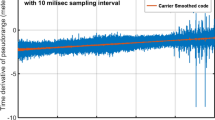Abstract
Ionospheric delays can be efficiently eliminated from single-frequency data using a combination of carrier phases and code ranges. Unfortunately, GPS and GLONASS ranges are relatively noisy which can limit the use of the positioning method. Nevertheless, position standard deviations are in the range of 6–8 cm (horizontal) and 7–9 cm (3d) obtained from diurnal data batches from selected IGS reference stations can be further reduced to 2–3 cm (3d) for weekly smoothed averages. GPS data sets collected in Ghana (Africa) reveal a typical level of 10 cm of deviation that must be anticipated under average conditions. Looking at the future of GNSS, the European Galileo system will, in contrast to GPS, provide the broadband signal E5 that is by far less affected by multipath thus providing rather precise range measurements. Simulated processing runs featuring both high ionospheric and tropospheric delay variations show a 3d position precision of 4 cm even for a data batch as short as just 1 h, whereas GPS L1/Galileo E1 performance is close to 13 cm for the same data set.











Similar content being viewed by others
References
Bassiri S, Hajj GA (1993) Higher-order ionospheric effects on the global positioning system observables and means of modelling them. Manuscripta Geodaetica 18:280–289
Bona P (2000) Precision, cross correlation, and time correlation of GPS phase and code observations. GPS Solut 4(2):3–13
Eissfeller B, Irsigler M, Avila-Rodriguez J-A, Schüler E, Schüler T (2007) Das europäische Satelliten-navigationssystem GALILEO—Entwicklungsstand; Allgemeine Vermessungsnachrichten AVN, 2/2007, S. 42-55, Wißner-Verlag, Heidelberg, February 2007
Irsigler M (2008) Multipath propagation, mitigation and monitoring in the light of Galileo and the modernized GPS. Dissertation, Faculty of Aerospace Engineering, University FAF Munich, Neubiberg, Germany
Issler J-L, Ries L, Bourgeade J-M, Lestarquit L, Macabiau C (2004) Probabilistic approach of frequency diversity as interference mitigation means. In: Proceedings of ION GNSS, 17th international technical meeting of the satellite division, 21–24 September 2004, Long Beach, CA, USA, pp 2136–2145
Montenbruck O, Yoon Y, Gill E, Garcia-Fernandez M (2006) Precise orbit determination for the TerraSAR-X mission. In: Proceedings of ISTS 2006-d-58, 19th international symposium on space flight dynamics, 4–11 June 2006, Kanazawa, Japan
Moreno R, Suard N, Lestarquit L (1999) Ionospheric delay using only L1: validation and application to GPS receiver calibration and to inter-frequency biases estimation. In: Proceedings of the 1999 national technical meeting of the Institute of Navigation, January 25–27, 1999, Catamaran Resort Hotel, San Diego, CA, USA, pp 119–125
Muellerschoen RJ, Iijima B, Meyer R, Bar-Sever Y, Accad E (2004) Real-time point-positioning performance evaluation of single-frequency receivers using NASA’s global differential GPS system. In: Proceedings of ION GNSS 2004, 17th international technical meeting of the satellite division, 21–24 September 2004, Long Beach, California, USA, pp 1872–1880
Schüler E (2008) Schnelle Präzise Positionierung mit GPS und GALILEO unter Nutzung aktiver Referenznetzwerke. Dissertation, University FAF Munich, Faculty of Aerospace Engineering, Neubiberg, Germany, 17 November 2008
Schüler T (2009) Long-baseline precise differential GPS positioning without use of active networks, Festschrift—60th Anniversary Guenter W. Hein, Institute of Geodesy and Navigation, University FAF Munich, Neubiberg, Germany, pp 243–256
Yunck TP (1996) Orbit determination. In: Parkinson BW, Spilker JJ (eds) Global positioning system—theory and applications. AIAA, Washington D.C.
Acknowledgments
IGS LEO network data were used in this study, and the authors would like to thank the maintainers of this network for free access to these data sets. The help of S. Rosenkranz for analysis of the Hawaiian test data sets that were documented in his diploma thesis “Ionosphärenfreie GPS-Positionierung mit Einfrequenz-Empfängern” (March 2009) is gratefully acknowledged. Finally, we would like to thank the reviewers and the editor in chief for their valuable comments and improvements to this manuscript.
Author information
Authors and Affiliations
Corresponding author
Rights and permissions
About this article
Cite this article
Schüler, T., Diessongo, H. & Poku-Gyamfi, Y. Precise ionosphere-free single-frequency GNSS positioning. GPS Solut 15, 139–147 (2011). https://doi.org/10.1007/s10291-010-0177-5
Received:
Accepted:
Published:
Issue Date:
DOI: https://doi.org/10.1007/s10291-010-0177-5




